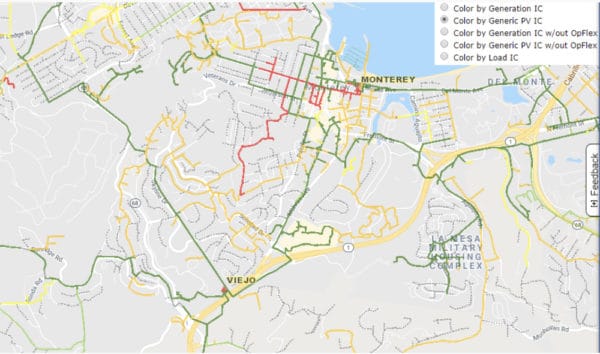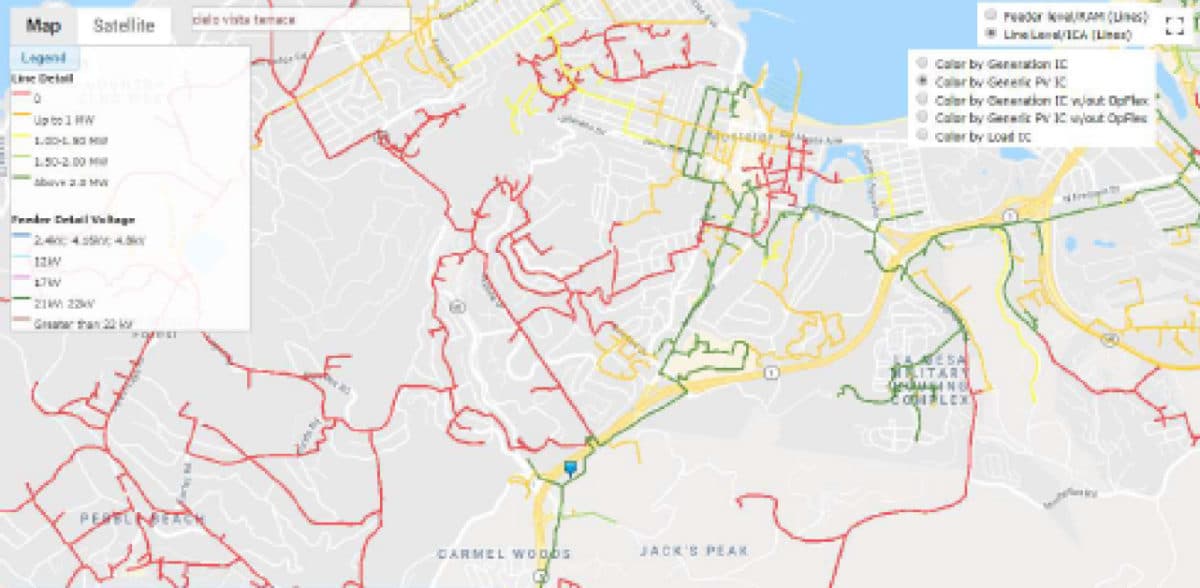The California utility PG&E’s first hosting capacity map showed little or no room for new distributed solar on 80% of its feeders, reports a paper from the Interstate Renewable Energy Council (IREC).
But after the utility corrected its hosting capacity analysis, the map showed “lots of green,” the paper says, indicating lots of room for solar—for example for Monterey, California, shown at right, compared to “lots of red” in the initial version shown above.
The IREC paper advises utilities to be pro-active in ensuring the accuracy of the maps—to save time for utility customers siting and designing new solar installations, and also for utility engineers performing interconnection studies.
Ultimately, a published set of best practices for validating hosting capacity maps is needed, the paper says, “so that stakeholders and regulators know if utilities are performing a comprehensive data validation effort.”
Seven states now require utilities to produce solar hosting capacity maps: California, Nevada, Minnesota, New York, Maryland, New Jersey, and Connecticut, according to Yochi Zakai, an attorney at Shute, Mihaly & Weinberger, LLP, who wrote the IREC paper and represents IREC in state proceedings.
In at least five more states, regulators are considering requiring utilities to produce such maps, or to improve the maps they are already publishing, Zakai said: Colorado, Illinois, Michigan, Massachusetts and New Hampshire. In Georgia, solar groups last year called for state regulators to require Georgia Power to produce such maps.
Accuracy
To investigate whether PG&E’s early solar hosting capacity results were accurate, California Public Utilities Commission staff worked with PG&E, IREC and other stakeholders. PG&E, after conducting validation work, “conceded that the solar results were erroneous,” says the IREC paper.
A PG&E spokesperson commented that “To date, PG&E has connected more than 475,000 solar customers to the electric grid and supports customers with resources before, during and after they go solar.”
The IREC paper describes how some utilities have worked to ensure accurate inputs to their hosting capacity analysis, and use automated flags to identify anomalous modeling results. But, the paper adds, “a comprehensive effort would likely include other checks not described here,” as no utility claims to have performed a comprehensive validation effort. Modeling experts could determine what those additional checks should be, the paper says.
Inaccurate results were also found in a different type of hosting capacity map produced by PG&E and two other California utilities, the IREC paper says: maps showing the capacity for added load on a circuit, such as electric vehicles. The three utilities, PG&E, SCE and SDG&E, “agreed that the questionable load results warrant investigation and refinement” of their methodology, the paper says.
An SDG&E spokesperson provided this comment: “SDG&E has continuously innovated, tested and improved the HCA tool by working with key stakeholders, including IREC and CPUC staff, to develop and refine the methodology. The tool functions well, as intended, to provide developers of large DERs early insight into grid locational hosting capacity. This tool isn’t applicable for the vast majority of DER project planning (around 98%) in SDG&E’s service territory. SDG&E has a fast track process in place to interconnect small DER installations (such as rooftop solar on single-family homes) within an average of three days. As for load capacity, it is important to understand that load capacity varies hourly throughout the year, depending on demand; if load capacity shows up as zero at one location and time, that doesn’t mean that it is zero year-round. SDG&E’s HCA tool allows users to see hourly changes in load capacity.”
IREC’s recommendations apply to both solar hosting capacity and load hosting capacity. The IREC paper is titled “Validation is critical to making hosting capacity analysis a clean energy game-changer.”
This content is protected by copyright and may not be reused. If you want to cooperate with us and would like to reuse some of our content, please contact: editors@pv-magazine.com.








Nice piece and I agree fully. I was involved in various CPUC regulatory proceedings on these maps and made the same kinds of comments frequently. The watchword is “actionable.” If the maps aren’t actionable (b/c they’re not accurate) they ‘re actually worse than useless. The next step beyond ensuring accuracy and actionability is automating interconnection applications based on specific map grid circuits and line sections, with “click and claim” capabilities that link these maps with automated interconnection portals. These next wave automation features will allow the distributed energy revolution to truly take off.